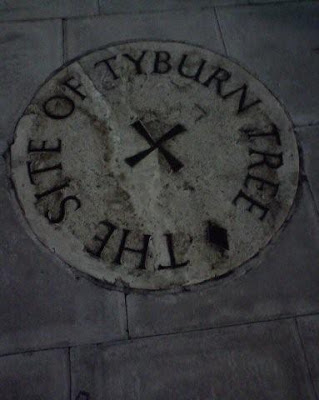
If you have done any reading about the history of executions, you will already be familiar with the

 Tyburn tree
Tyburn tree. This most famous of gallows was located in the center of London and was used to carry out public executions on Mondays, from 1596 to 1783 (although the site had been used for this purpose since the 13th century). A typical crowd would number 10,000, but the morbid events would sometimes draw more than 50,000. Also known as the "triple tree" because of its configuration (
2nd image), it was used to hang multiple condemned prisoners simultaneously - the most being 24 in 1649. Five of those hanged from Tyburn tree were children under the age of 14, and a small percentage were women, but
most were men under age 21.
Capitalpunishment.org describes a typical 1750s execution at Tyburn:
"The execution process began at around 7 o'clock in the morning when the condemned men and women would be led in fetters (handcuffs and leg-irons) into the Press Yard in Newgate. Here the blacksmith would remove the fetters and the Yeoman of the Halter would tie the criminals' hands in front of them (so that they were able to pray when they reached Tyburn) and place the rope (or halter, as it was known) round their necks, coiling the free end round their bodies....When the pinioning was completed, they were placed in open horse drawn carts sitting on their coffins and the procession consisting of the Under Sheriff, the Ordinary (Newgate's prison chaplain), the hangman and his assistants, and a troop of javelin men started out for Tyburn about two miles away. The streets would be lined with crowds, especially if the criminals were particularly notorious, and there would often be insults and more solid objects hurled at them and their escorts on the way. A stop was often made at St. Sepulchre's Church and two public houses along the way where the criminals were customarily given a drink....On arrival at Tyburn, often some three hours later, the condemned were greeted by a large unruly crowd who had come to watch the spectacle - it was considered an excellent day out. The carts were each backed under one of the three beams of the gallows and the prisoners were positioned at the tail of the cart and tied up to the beam with only a small amount of slack left in the rope. The Ordinary would pray with them and when he had finished, the hangman pulled white night caps over their faces. When everything was ready, the horses were whipped away leaving the prisoners suspended. They would only have a few inches of drop and thus many of them would writhe in agony for some moments. The hangman, his assistants and sometimes the prisoners' relatives might pull on the prisoners' legs to hasten their end. After half an hour or so, the bodies were cut down and claimed by friends and relatives or in the case of murderers, sent for dissection at Surgeons' Hall."
The location of this infamous site is marked (
3rd image) at the
junction of N.E. Hyde Park, Edware Road, and Oxford Street.
Tyburn Convent (
be sure to click on their sophisticated website) is located nearby and honors the more than 100 Catholic martyrs put to death there during the Protestant Reformation, as depicted in a stained glass window (
1st image).
 If you have done any reading about the history of executions, you will already be familiar with the
If you have done any reading about the history of executions, you will already be familiar with the 
 Tyburn tree. This most famous of gallows was located in the center of London and was used to carry out public executions on Mondays, from 1596 to 1783 (although the site had been used for this purpose since the 13th century). A typical crowd would number 10,000, but the morbid events would sometimes draw more than 50,000. Also known as the "triple tree" because of its configuration (2nd image), it was used to hang multiple condemned prisoners simultaneously - the most being 24 in 1649. Five of those hanged from Tyburn tree were children under the age of 14, and a small percentage were women, but most were men under age 21. Capitalpunishment.org describes a typical 1750s execution at Tyburn:
Tyburn tree. This most famous of gallows was located in the center of London and was used to carry out public executions on Mondays, from 1596 to 1783 (although the site had been used for this purpose since the 13th century). A typical crowd would number 10,000, but the morbid events would sometimes draw more than 50,000. Also known as the "triple tree" because of its configuration (2nd image), it was used to hang multiple condemned prisoners simultaneously - the most being 24 in 1649. Five of those hanged from Tyburn tree were children under the age of 14, and a small percentage were women, but most were men under age 21. Capitalpunishment.org describes a typical 1750s execution at Tyburn: 








No comments:
Post a Comment
You may add your comments here.